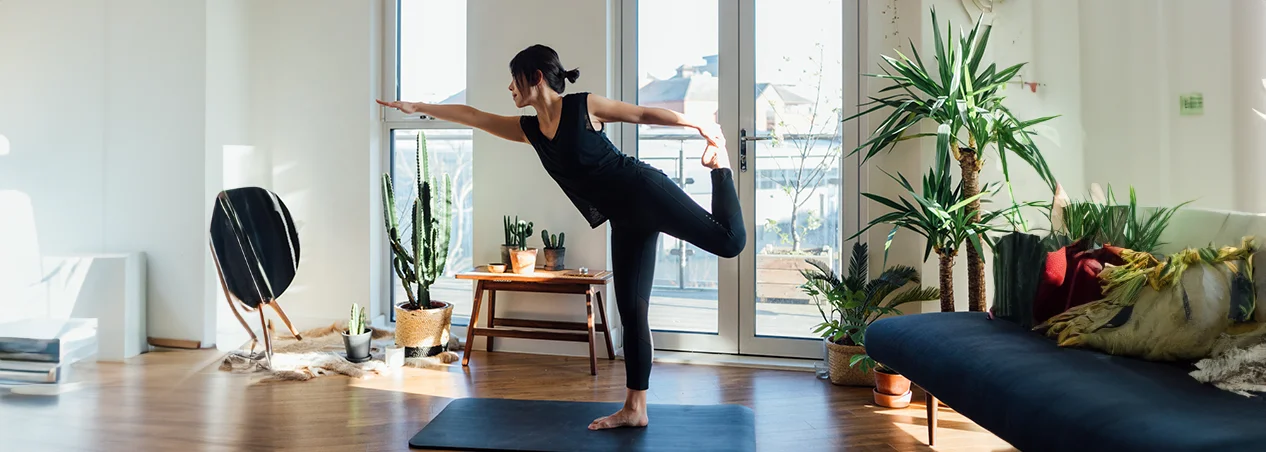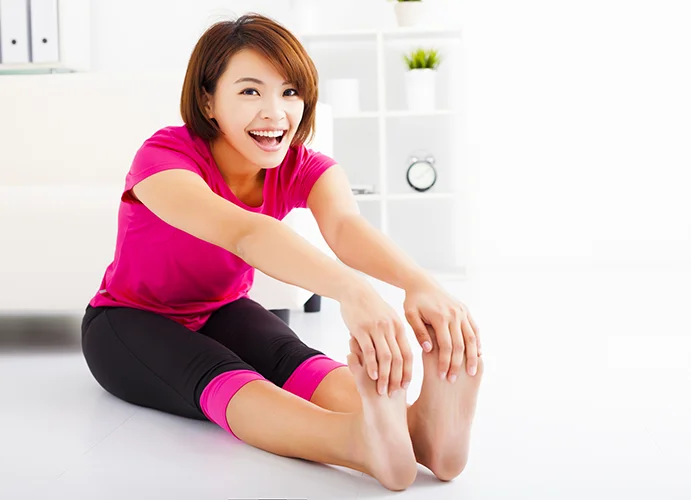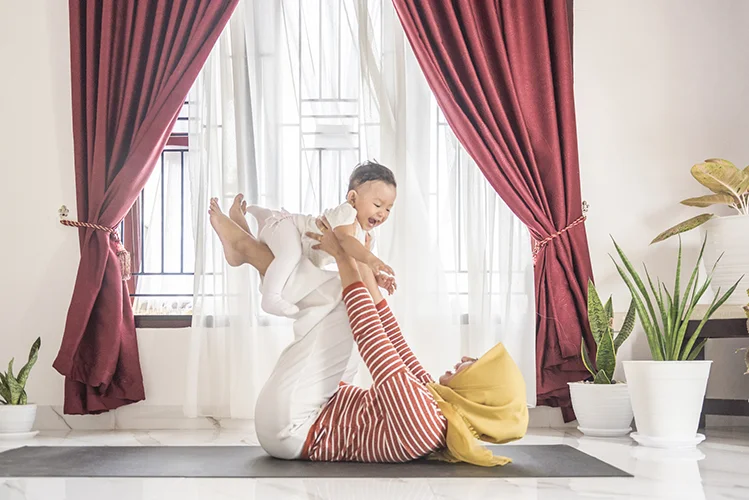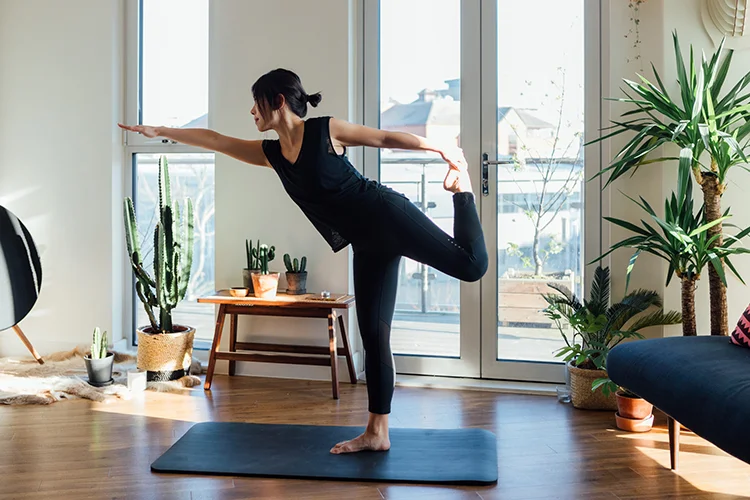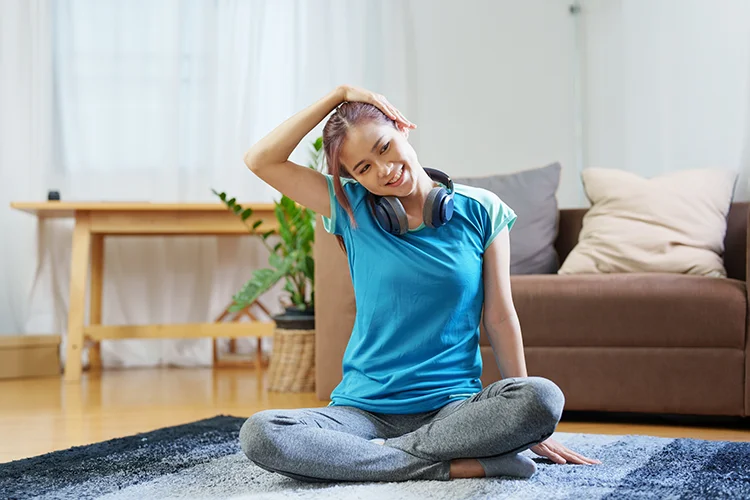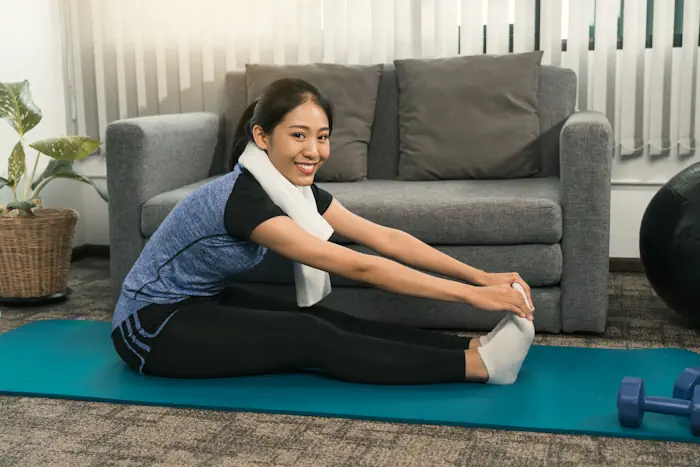Topics
In today’s fast-paced world, finding time to go to the gym can be a challenge, making at-home workouts an increasingly popular option for many, especially women.
Whether you are a busy professional or a stay-at-home mom, incorporating exercise into your daily routine is essential for maintaining a healthy lifestyle.
From toning your muscles to improving your heart health, these exercises will help you hit your fitness goals right from the comfort of your home. Let’s explore the benefits of at-home workouts and how you can seamlessly incorporate them into your fitness journey.
What Is a Home Workout?
A home workout is a convenient and flexible alternative to traditional gym sessions while offering an efficient way to stay active and healthy. Additionally, it may even reduce the risks of injuries when going about your daily physical responsibilities.
What Are the Benefits and Advantages of At-Home Workouts?
- Time flexibility and convenience: At-home workouts allow you to exercise on your schedule, fitting seamlessly into your daily routine.
- Privacy and comfort: Working out at home provides a comfortable and private environment where you can focus on your goals without self-consciousness.
- Cost-effectiveness: With no gym fees or commuting expenses, at-home workouts are budget-friendly.
- Personalisation: Tailor your workout routine to your preferences and goals, choosing exercises that align with your fitness objectives.
What Are the At-Home Workout Exercises for Women?
While there are ample ways to begin this journey, here are some simple workouts to motivate you towards a better, stronger, and healthier you.
Abs workouts at home
Engaging in abs workouts at home promotes a strong core. A strong core aids in performing daily activities like lifting, bending, and twisting, thus reducing the risk of injuries during everyday tasks.
- The standard position is to get on your hands and knees and walk your hands forward until you come to a push-up position. Your hands should be shoulder-width apart and your feet hip-width apart.
- Lift your knees off the ground, such that you are balancing on your toes and hands.
- Keep your body aligned from your head to your heels throughout the exercise to avoid straining your back or neck.
- Engage the core muscles by pulling your stomach towards your spine while tightly squeezing your glutes.
- Hold this for 15-30 seconds and lower your knees to the ground once you feel tired.
- Sit on the ground, while leaning your torso back at an angle.
- Next, lift your feet off the ground before twisting your torso from side to side.
- You may add external resistance (using a kettlebell, or dumbbell) to make it more effective.
- Stay tall during the movement with your neck long and shoulders back, keeping your back flat.
- Avoid rounding your upper back or shoulders. Rotation should come from the belly button upwards, and not only the hands.
Leg workouts at home
Leg workouts enhance lower body strength which is vital for activities like walking and climbing stairs while improving balance and mobility, thus reducing the risk of injuries in the knees and hips.
- Stand with feet a little wider than your hip-width.
- Slowly sit into a squat position while keeping your heels and toes on the ground, chest up and shoulders back; knees bent to a 45 to 90-degree angle. Make sure your knees are not exceeding your toes.
- Straighten your legs to return to a standing position.
- Do three sets of 10-12 repetitions three times weekly.
- Start with a standing position keeping your feet hip-width apart and step forward so that one leg is ahead of your torso and the other is behind.
- Bend your knees at approximately 45 to 90 degrees as you lower yourself. Make sure your knees are not exceeding your toes. Your rear knee should not touch the ground.
- Keep your back straight for stability during the exercise.
- Then, forcefully push yourself back up to the starting position.
- For a beginner, take smaller steps and begin with only 2-3 sets of 10-12 repetitions for each leg.
- Do not continue this exercise if any knee pain arises before or during the exercise.
Arm workouts at home
Engaging in weight-bearing arm exercises supports bone health and density, reduces the risk of osteoporosis, and contributes to better performance in daily tasks like carrying groceries, lifting objects, and more.
- Stand tall and straight keeping your feet hip-width apart. Engage your core muscles.
- Hold a dumbbell in each hand, arms relaxed at your sides with palms facing forward.
- Stabilise your upper arms and relax and lock your shoulders.
- Bend your elbows, raising the dumbbells towards your shoulders.
- For a full motion, lift them to your forehead level; keeping elbows close to your body and shoulders stay still. Exhale as you lift.
- Return the weights to the initial position.
- Complete the desired reps, keeping within 10-12 repetitions.
- Perform a triceps extension by lying on your back, holding a dumbbell in one hand.
- Angle your upper arm towards the ceiling, keeping your elbow bent at a 90-degree angle.
- Gradually extend your elbow to lift the weight upward, then lower it back down slowly to the starting point. You will experience tension in the muscles at the back of your upper arm.
- When executing triceps extensions, maintain a fluid and unhurried arm movement.
- If you find it challenging to stabilise your arm, utilise your opposite hand to assist in maintaining the 90-degree arm position during each extension.
- Triceps extensions can be performed on a weight bench or on the floor.
- A set of 10-12 repetitions should be adequate.
Full body workout at home
Full-body workouts offer a comprehensive exercise session that engages multiple muscle groups in a shorter span of time. It helps in improving flexibility, thereby, reducing the risk of muscle imbalances and injuries.
- Begin with a high-plank position, with both hands straight, and pull your knee towards your chest as much as you can.
- Switch your legs by pulling one knee out and the other in.
- Keep your hips down and run your knees in and out as far and as fast as possible with your toes touching the ground.
- Repeat 2-3 sets.
- Stand with your feet shoulder-width apart.
- Then drop down into a squat position, placing your hands on the ground in front of you.
- From the squat position, kick your feet back into a plank position while lowering your body down to the ground by bending your arms. Do this while keeping your elbows close to your body.
- Once you are on the ground, push yourself back up into the plank position and jump your feet forward to return to the squat position.
- Stand up and jump up, trying to reach your hands overhead.
- Land softly, and immediately drop down into the squat position to begin the next repetition.
- Repeat 10-12 reps for 2-3 sets.
- Use a slightly weighted rope for optimum experience and results.
- Keep your hands roughly the same distance apart from the centreline of your body.
- Ensure minimal movement of the elbows and shoulders. Your wrists should generate the jump rope rotation.
- Keeping your toes pointed down and your knees slightly bent, while landing softly on the balls of your feet every jump.
- Jump continuously for 1 minute and repeat for another 2-5 sets for 1 minute each set.
The push-up: Upper body, chest, triceps, and shoulder workout at home
Push-ups not only contribute to cardiovascular fitness but also lay the groundwork for more robust resistance training.
- The best way to begin is by doing a wall push up as it puts the least pressure on the joints.
- Position yourself with your feet shoulder-width, standing approximately an arm’s length from a wall.
- Rest your palms against the wall as you incline forward into a standing plank stance.
- Ensure your arms are both at shoulder height and positioned shoulder-width apart.
- Inhale deeply as you flex your elbows, gradually guiding your upper body towards the wall while maintaining your feet flat on the floor. Maintain this posture for a brief moment.
- Exhale steadily, employing your arm strength to gently return your body to its initial stance.
How to Start a Home Workout Routine?
- Set clear goals: Define your fitness objectives. It could be anything from weight loss to muscle gain, or overall fitness.
- Create a schedule: Allocate a specific time each day for your workouts to establish consistency.
- Warm-up and cool down: Prioritise warm-up exercises and stretching to prevent injuries and aid recovery.
- Stay hydrated: Keep water nearby to stay hydrated throughout your workout.
- Variety is key: Rotate exercises to prevent boredom and challenge different muscle groups.
How to Warm Up Before Working Out at Home?
Warm-ups are equally important to enhance physical performance and to prevent injuries. This is a great way to begin your warm-up.
- March in place: Lift your knees and swing your arms for 2-3 minutes.
- Arm circles: Rotate your arms in forward and backward circles to increase shoulder mobility.
- Leg swings: Swing each leg forward and backwards to activate your hip muscles.
- Torso twists: Gently twist your torso from side to side to engage your core.
Frequently Asked Questions (FAQs)
Yes, a well-structured home workout combined with a balanced diet can aid in weight loss by burning calories and improving overall fitness.
Home workouts can be equally effective, as they allow you to engage in a variety of exercises that target different muscle groups.
Yes, with proper resistance and progressive overload, home workouts will lead to muscle development. However individual results may vary based on factors such as genetics, age, nutrition, and the specific exercises performed.
If your fitness goals align with what home workouts can provide and you are able to structure a well-balanced routine that includes cardio, strength training, flexibility, and mobility exercises, then working out at home is enough.
It is best to work out 2-3 alternate days a week. Working out every day may put too much strain on your muscles, lack of muscle recovery time, and increases risk injuries.
Aim for 150 minutes of moderate-intensity activities (aerobics) per week. Alternatively, you may do 75 minutes of vigorous-intensity activity per week. Getting enough sleep and allowing muscle groups to recover between workout sessions is essential for optimal muscle development.
For an effective workout start with 20-30 minutes of exercise and gradually increase the duration based on your fitness level.
Make an Appointment at Pantai Hospitals
Whether you are a beginner or an experienced fitness enthusiast, the power of at-home workouts is undeniable, helping achieve your desired level of fitness while balancing your busy lifestyle.
Remember, consistency and gradual progression are key to reaping the full benefits of your home workout routine. Prioritise your health and well-being by including these exercises in your daily routine, and start a journey towards a stronger, healthier you.
Get in touch with us to book an appointment with our team of gynaecologists and physiotherapists today, or find out more about our Obstetrics and Gynaecology Services, as well as our Physiotherapy and Rehabilitation Services at your nearest Pantai Hospital.
Pantai Hospitals have been accredited by the Malaysian Society for Quality in Health (MSQH) for its commitment to patient safety and service quality.
This article has been reviewed by the Pantai Integrated Rehab team.



